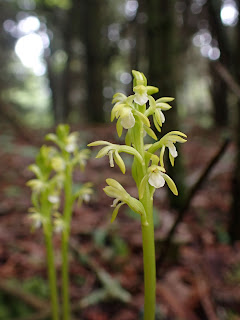The wide, winding boardwalk accommodated Karen, Coggin, and me easily, as we remarked on the deep shade of the cedar forest while listening for birds and keeping our eyes open for neat plants. These two seasoned naturalists were excellent guides on my recent trip to the Door Peninsula, and they spotted the coralroot orchids I wrote about a few weeks ago.
A splash of color up ahead, in the wetland just off the side of the boardwalk, had us quickening our pace. Here was another orchid, one they’d been sure we’d find here, the Yellow Lady’s Slipper orchid. The big yellow pouch was plump and sunny, glistening with raindrops from a passing shower. The lateral petals were gracefully twisted and artfully striped with maroon. Deeply veined leaves framed the flower perfectly.
And then we saw them everywhere! A dozen – at least – in a single wetland. Pairs and triplets in the forest shade. We’d hit peak bloom. And they were everywhere, in all different habitats.
Here, at The Ridges Sanctuary in Bailey’s Harbor, Wisconsin, there are quite a few habitats to choose from. The sanctuary protects about 30 narrow, crescent-shaped, sandy ridges, with damp hollows and wetlands in between. They represent a progression of beach lines from 1,500 years of changing water levels in Lake Michigan. With the lake as an air conditioner, the area supports plants who typically thrive much farther north – and near Lake Superior.
Spruce, fir, and pine mix with an abundance of northern white cedar. The sand ridges also support unusual species, like creeping juniper and dwarf lake iris. The valleys hold boggy mats of Sphagnum moss or fens filled with gracefully arching sedges. And Yellow Lady’s Slipper orchids seemed to grow everywhere!
 |
| Creeping Juniper on the left, and Common Juniper on the right. Photo by Emily Stone. |
 |
| Dwarf Lake Iris |
I suppose that shouldn’t come as a big surprise. According to the Minnesota Wildflowers website, Yellow Lady’s Slipper orchids are the most common wild orchid in the U.S. and are found in almost every state. They seem to make themselves at home in quite a range of habitats, from sugar maple forests, to wetlands, and even prairies. That list runs the full spectrum of soil moisture!
Winding our way through the network of trails and the pattern of habitats, I was also delighted to find a few blossoms of Bird's-eye Primrose who hadn’t faded completely. After seeing them in Alaska and on the North Shore of Minnesota, I felt like I’d achieved a trifecta. The pure sand they grew from looked quite different than the mossy pockets of bedrock or tundra where we’d first met. Just like with the Yellow Lady’s Slipper orchid, they seem to find what they need in disparate places.
.JPG) |
| Bird's Eye Primrose |
Our next target species would not be so easy to find. Ram’s Head orchids are clearly related to Yellow Lady’s Slippers, in the genus Cypripedium. Although their floral pouch is white with raspberry-colored veins, the general shape is recognizable. I tend to think they look more like yet another lady’s slipper, or perhaps a fairy’s slipper, instead of the head of a charging ram.
These orchids are rare throughout their limited range, but still manage to occupy a surprising variety of habitats. In Minnesota, they like jack pine and red pine forests, which tend to be dry. In Maine, they grow in mixed conifer/hardwood forests. And here in The Ridges, they are found in the darkest corners of the cedar and black spruce swamps.
The Minnesota DNR, on their page describing the orchid as a state threatened species, explains that, “the underlying habitat elements that are of greatest importance to C. arietinum are probably the health of the mycorrhizal community and the composition of the pollinator community.”
Indeed, like the coralroot orchids I wrote about previously, both of these orchids require a mycorrhizal community – fungus (myco-) attached to their roots (-rhizal). First, dust-like orchid seeds need a fungus to provide them with water and food while they germinate. Then the fungi continue to provide additional resources to the orchid while they grow in the deep shade with few leaves of their own. The orchids don’t seem to provide a benefit to the fungus…unless mushrooms also like beauty?
Beauty seems to be the only reward for the pollinators of orchids. Many plants produce sweet nectar and protein-rich pollen to entice bees to visit their flowers, but orchids produce no nectar and package their pollen into tight bundles that the bees can’t use. To achieve pollination, the flowers rely on their gaudy beauty, the scent of vanilla, and naïve queen bees who’ve just woken up from hibernation.
A bee follows lovely patterns of nectar guides down into the flower’s pouch, drops a pollen packet off (if she has one) on the stigma where it will fertilize thousands of seeds, and then passes by the anthers, which glue a new pollen packet from this flower onto her back. To add insult to injury, bees who are too big might become trapped if they can’t fit through the flower’s exit hole.
 |
| The Trail |
.JPG) |
| Ram’s Head orchid |
Since the fungi, forest community, and pollination have to coalesce perfectly for an orchid to bloom, we felt lucky to be in the right place at the right time.
Emily’s award-winning second book, Natural Connections: Dreaming of an Elfin Skimmer, is available to purchase at www.cablemuseum.org/books and at your local independent bookstore, too.
For more than 50 years, the Cable Natural History Museum has served to connect you to the Northwoods. The Museum is open with our brand-new exhibit: “Anaamaagon: Under the Snow.” Our Summer Calendar of Events is open for registration! Follow us on Facebook, Instagram, YouTube, and cablemuseum.org to see what we are up to.












